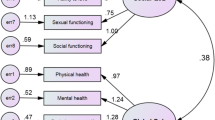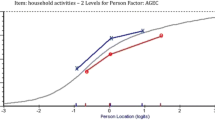Abstract
Aims
To confirm the factorial structure of the Short Form 36 Health Survey (SF-36) in problem drug users and to compare their health-related quality of life (HRQOL) with general Dutch population norms.
Method
Data of 394 participants from the Amsterdam Cohort Study among drug users, who had completed once the SF-36 standard form (4 weeks recall) between February and August 2005, were analyzed. The factorial structure of the SF-36 was investigated by confirmatory factor analysis. Subsequently, sum scores of the eight SF-36 health dimensions were converted into z-scores by standardizing them with the mean and standard deviation of the corresponding general Dutch population age and gender group.
Results
The factor structure was acceptable and also comparable with previous findings. Compared with the general population, participants had significantly lower z-scores on all of the eight SF-36 dimensions, with largest deviations in social functioning (M = −1.13) and mental health (M = −1.01), and smallest deviations in bodily pain (M = −0.32).
Conclusion
The results corroborate the factorial structure and reliability of the answers of problem drug users to the SF−36. Their HRQOL was low, even though it was assessed irrespective of substance abuse treatment settings.



Similar content being viewed by others
Abbreviations
- ACS:
-
Amsterdam Cohort Studies among drug users
- AIDS:
-
Acquired immunodeficiency syndrome
- BP:
-
Bodily pain
- CFA:
-
Confirmatory factor analysis
- CFI:
-
Comparative fit index
- GH:
-
General health
- HIV:
-
Human immunodeficiency virus
- HRQOL:
-
Health-related quality of life
- IQR:
-
Interquartile range
- M:
-
Mean
- MH:
-
Mental health
- PDU:
-
Problem drug users
- PF:
-
Physical functioning
- QOL:
-
Quality of life
- RE:
-
Role limits emotional
- RMSEA:
-
Root-mean-square error of approximation
- RP:
-
Role limits physical
- SD:
-
Standard deviation
- SF:
-
Social functioning
- SF-36:
-
Short Form 36 Health Survey
- STD:
-
Sexually transmitted diseases
- TLI:
-
Tucker Lewis index
- VT:
-
Vitality
- WLSMV:
-
Weighted least-square mean and variance adjusted
Reference List
European Monitoring Centre for Drugs and Drug Addiction (2007). Annual Report 2007 Lisbon: European Monitoring Centre for Drugs and Drug Addiction.
McLellan, A. T., Lewis, D. C., O’Brien, C. P., & Kleber, H. D. (2000). Drug dependence, a chronic medical illness Implications for treatment, insurance and outcomes evaluation. JAMA, 284, 1689–1695.
Connor, J. P., Saunders, J. B., & Feeney, G. F. X. (2006). Quality of life in substance use disorders. In H. Katschnig, H. Freeman & N. Sartorius (Eds.), Quality of life in mental disorders (2nd ed., pp. 199–208). Chichester: Wiley.
Deering, D., Frampton, C., Horn, J., Sellman, D., Adamson, S., & Potiki, T. (2004). Health status of clients receiving methadone maintenance treatment using the SF-36 health survey questionnaire. Drug and Alcohol Review, 23, 273–280.
Smith, K. W., & Larson, M. J. (2003). Quality of life assessments by adult substance abusers receiving publicly funded treatment in Massachusetts. American Journal of Drug and Alcohol Abuse, 29, 323–335.
Stein, M. D., Mulvey, K. P., Plough, A., & Samet, J. H. (1998). The functioning and well being of persons who seek treatment for drug and alcohol use. Journal of Substance Abuse, 10, 75–84.
Millson, P. E., Challacombe, L., Villeneuve, P. J., Fischer, B., Strike, C. J., Myers, T., et al. (2004). Self-perceived health among Canadian opiate users: A comparison to the general population and to other chronic disease populations. Canadian Journal of Public Health, 95, 99–103.
Ryan, C. F., & White, J. M. (1996). Health status at entry to methadone maintenance treatment using the SF-36 health survey questionnaire. Addiction, 91, 39–45.
Richter, D., Eikelmann, B., & Berger, K. (2004). Use of the SF-36 in the evaluation of a drug detoxification program. Quality of Life Research, 13, 907–914.
Neale, J. (2004). Measuring the health of Scottish drug users. Health & Social Care in the Community, 12, 202–211.
Garratt, A., Schmidt, L., Mackintosh, A., & Fitzpatrick, R. (2002). Quality of life measurement: Bibliographic study of patient assessed health outcome measures. BMJ, 324, 1417.
Ware, J. E., Jr. (2004). SF-36 health survey update. In M.E. Maruish (Ed.), The use of psychosocial testing for treatment planning and outcome assessment (3 ed., pp. 695–720). Lawrence Erlbaum Associates).
Coons, S. J., Rao, S., Keininger, D. L., & Hays, R. D. (2000). A comparative review of generic quality-of-life instruments. Pharmacoeconomics, 17, 13–35.
Ware, J. E., Jr., Kosinski, M., Gandek, B., Aaronson, N. K., Apolone, G., Bech, P., et al. (1998). The factor structure of the SF-36 Health Survey in 10 countries: Results from the IQOLA Project. International Quality of Life Assessment. Journal of Clinical Epidemiology, 51, 1159–1165.
Ware, J. E., Snow, K. K., Kosinski, M., & Gandek, B. (1993). SF-36 Health Survey. Manual & Interpretation Guide. Boston, Massachusetts: The Health Institute, New England Medical Center.
Ware, J. E., & Kosinski, M. (2001). Interpreting SF-36 summary health measures: A response. Quality of Life Research, 10, 405–413.
Taft, C., Karlsson, J., & Sullivan, M. (2001). Do SF-36 summary component scores accurately summarize subscale scores? Quality of Life Research, 10, 395–404.
Taft, C., Karlsson, J., & Sullivan, M. (2001). Editorial comment: Reply to Drs Ware and Kosinski. Quality of Life Research, 10, 415–420.
Simon, G. E., Revicki, D. A., Grothaus, L., & VonKorff, M. (1998). SF-36 summary scores: Are physical and mental health truly distinct? Medical Care, 36, 567–572.
Keller, S. D., Ware, J. E., Jr., Bentler, P. M., Aaronson, N. K., Alonso, J., Apolone, G., et al. (1998). Use of structural equation modeling to test the construct validity of the SF-36 Health Survey in ten countries: Results from the IQOLA Project. International Quality of Life Assessment. Journal of Clinical Epidemiology, 51, 1179–1188.
Haynes, S. N., Nelson, K., & Blaine, D. D. (1999). Psychometric issues in assessment research. In P. C. Kendall, J. N. Butcher & G. N. Holmbeck (Eds.), Handbook of research methods in clinical psychology (2nd ed., pp. 125–154). New York: John.
Messick, S. (1995). Validity of psychological assessment: Validation of inferences from persons’ responses and performances as scientific inquiry into score meaning. American Psychologist, 50, 741–749.
Reno, R. R., & Aiken, L. S. (1993). Life activities and life quality of heroin addicts in and out of methadone treatment. International Journal of the Addictions, 28, 211–232.
Aiken, L. S. (1986). Retrospective self-reports by clients differ from original reports: Implications for the evaluation of drug treatment programs. International Journal of the Addictions, 21, 767–788.
van den Hoek, J. A., Coutinho, R. A., van Haastrecht, H. J., van Zadelhoff, A. W., & Goudsmit, J. (1988). Prevalence and risk factors of HIV infections among drug users and drug-using prostitutes in Amsterdam. AIDS, 2, 55–60.
Aaronson, N. K., Muller, M., Cohen, P. D., Essink-Bot, M. L., Fekkes, M., Sanderman, R., et al. (1998). Translation, validation, and norming of the Dutch language version of the SF-36 Health Survey in community and chronic disease populations. Journal of Clinical Epidemiology, 51, 1055–1068.
Langendam, M. W., van Haastrecht, H. J., & van Ameijden, E. J. (1999). The validity of drug users’ self-reports in a non-treatment setting: Prevalence and predictors of incorrect reporting methadone treatment modalities. International journal of Epidemiology, 28, 514–520.
Sijtsma, K., & van der Ark, L. A. (2003). Investigation and treatment of missing item scores in test and questionnaire data. Multivariate Behavioral Research, 38, 505–528.
van Ginkel, J. R., & van der Ark, L. A. (2005). SPSS syntax for missing value imputation in test and questionnaire data. Applied Psychological Measurement, 29, 152–153.
Muthèn, L. K., & Muthèn, B. O. (2006). Mplus 4.1. Los Angeles: Muthèn & Muthèn.
Glöckner-Rist, A., & Hoijtink, H. (2003). The best of both worlds: Factor analysis of dichotomous data using item response theory and structural equation modeling. Structural Equation Modeling, 10, 544–565.
Flora, D. B., & Curran, P. J. (2004). An empirical evaluation of alternative methods of estimation for confirmatory factor analysis with ordinal data. Psychological Methods, 9, 466–491.
Finney, S. J., & DiStefano, C. (2006). Nonnormal and categorical data in structural equation modeling. In G. R. Hancock & R. O. Mueller (Eds.), Structural equation modeling. A second course (pp. 269–314). Greenwich, Conneticut: Information Age.
Marsh, H. W., Hau, K.-T., & Grayson, D. (2005). Goodness of fit in structural equation models. In A. Maydeu-Olivares & J. J. McArdle (Eds.), Contemporary psychometrics (pp. 275–340). Mahwah, NJ: Lawrence Erlbaum
Brown, M. W., & Cudeck, R. (1993). Alternative ways of assessing model fit. In K. A. Bollen & J. S. Long (Eds.), Testing structural equation models (pp. 136–162). Newbury Park, CA: Sage.
Wirtz, M. (2004). Über das Problem fehlender Werte: Wie der Einfluss fehlender Informationen auf Analyseergebnisse entdeckt und reduziert werden kann. [On the problem of missing data: How to identify and reduce the impact of missing data on findings of data analysis]. Rehabilitation, 43, 109–115.
Cohen, J. (1988). Statistical power analysis for the social sciences. Hillsdale, New Jersey: Lawrence Erlbaum.
Bollen, K. A. (1989). Structural equations with latent variables. New York: Wiley.
Reed, P. J. (1998). Medical outcomes study short form 36: Testing and cross-validating a second-order factorial structure for health system employees. Health Services Research, 33, 1361–1380.
Maurischat, C., Bestmann, A., Hasenbein, U., & Bullinger, M. (2004). Strukturelle Validität des Short Form 36 Health Survey (SF-36) bei neurologischen Patienten [Structural validity of the Short Form 36 (SF-36) in patients with neurological diseases]. Neurologie & Rehabilitation, 10, 13–20.
Vandenberg, R. J., & Lance, C. E. (2000). A review and synthesis of the measurement invariance literature: Suggestions, practices, and recommendations for organizational research. Organizational Research Methods, 3, 4–70.
Cheung, G. W., & Rensvold, R. B. (1999). Testing factorial invariance across groups: A reconceptualization and proposed new method. Journal of Management, 25, 1–27.
Morgan, T. J., Morgenstern, J., Blanchard, K. A., Labouvie, E., & Bux, D. A. (2003). Health related quality of life for adults participating in outpatient substance abuse treatment. The American Journal on Addictions, 12, 198–210.
Cortina, J. M. (1993). What is coefficent alpha? An examination of theory and applications. Journal of Applied Psychology, 78, 98–104.
Torrens, M., San, L., Martinez, A., Castillo, C., Domingo-Salvany, A., & Alonso, J. (1997). Use of the Nottingham Health Profile for measuring health status of patients in methadone maintenance treatment. Addiction, 92, 707–716.
Rose, M. S., Koshman, M. L., Spreng, S., & Sheldon, R. (1999). Statistical issues encountered in the comparison of health-related quality of life in diseased patients to published general population norms: Problems and solutions. Journal of Clinical Epidemiology, 52, 405–412.
Compton, M. A. (1994). Cold-pressor pain tolerance in opiate and cocaine abusers: Correlates of drug type and use status. Journal of Pain and Symptom Management, 9, 462–473.
Doverty, M., White, J. M., Somogyi, A. A., Bochner, F., Ali, R., & Ling, W. (2001). Hyperalgesic responses in methadone maintenance patients. Pain, 90, 91–96.
Compton, P., Charuvastra, V. C., Kintaudi, K., & Ling, W. (2000). Pain responses in methadone-maintained opioid abusers. Journal of Pain and Symptom Management, 20, 237–245.
Ho, A., & Dole, V. P. (1979). Pain perception in drug-free and in methadone-maintained human ex-addicts. Proceedings of the Society for Experimental Biology and Medicine, 162, 392–395.
Acknowledgements
The Amsterdam Cohort Studies on HIV infection and AIDS, a collaboration between the Amsterdam Health Service, the Academic Medical Center of the University of Amsterdam, the Sanquin Blood Supply Foundation, and the University Medical Center Utrecht, are part of the Netherlands HIV Monitoring Foundation and financially supported by the Netherlands National Institute for Public Health and the Environment. The authors wish to thank Joke Bax, Ans Snuverink, and Hella Brandt for their help with the collection and entry of the data. We also thank Maria Prins and Angelika Glöckner-Rist for helpful comments on previous drafts of the manuscript and Lucy Phillips for editorial assistance.
Author information
Authors and Affiliations
Corresponding author
Rights and permissions
About this article
Cite this article
Buchholz, A., Krol, A., Rist, F. et al. An assessment of factorial structure and health-related quality of life in problem drug users using the Short Form 36 Health Survey. Qual Life Res 17, 1021–1029 (2008). https://doi.org/10.1007/s11136-008-9371-0
Received:
Accepted:
Published:
Issue Date:
DOI: https://doi.org/10.1007/s11136-008-9371-0




